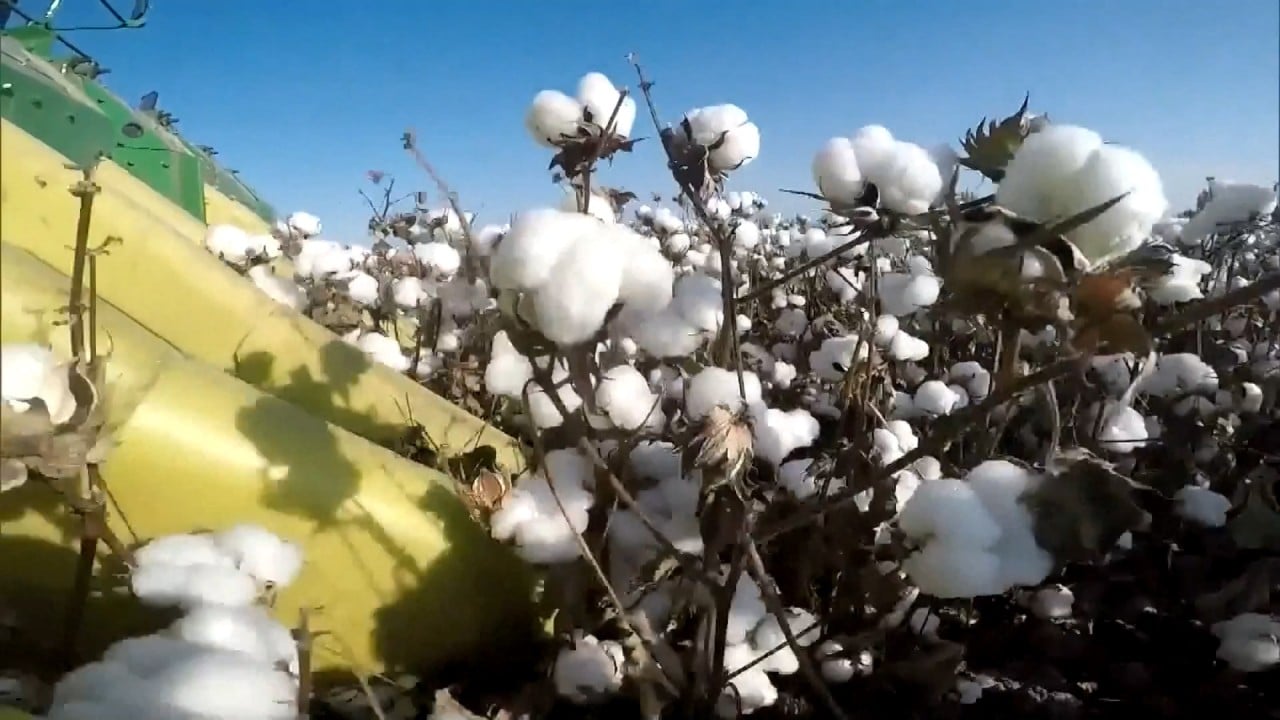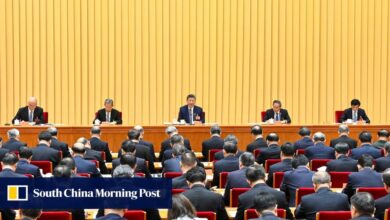China has turned inward to sell Xinjiang cotton after a trade ban. Will it be enough?

Hong’s new line in Xinjiang made him a perfect fit for the China-Eurasia Expo in the regional capital Urumqi last June, where authorities invited him to display his home-grown wares and help promote the local economy.
Global retailers have been under pressure to sever their supply chains from Xinjiang – China’s largest cotton-growing region – after allegations over the use of forced labour began to surface in the US and European Union as early as 2019.
International clothing brands – most notably Nike and H&M – responded to those concerns in 2020 with statements disavowing any links to the region. The next year, when legislation began to work its way through Western legislatures, those statements resurfaced and sent Chinese internet users into a furore.
But even with its considerable size, Hong said, the domestic market does not fill the void created by the departure of foreign customers.
“It is true that we are seeing our costs halved in Xinjiang, but our overall profits are nothing like before,” he said. “The orders just don’t make up.”
‘We needed a way out’
While Beijing has denied these allegations, the Uygur Forced Labour Prevention Act – a ban of all imports from Xinjiang unless a “rebuttable presumption” of forced labour can be successfully disputed – passed the US Congress in late 2021 and was enacted in June 2022.
We were losing one-third of our business just from Americans cutting orders
While there is little public data available to gauge the full impact the act had on Xinjiang’s economy, the region has seen a 54.6 per cent drop in foreign direct investment, with only US$50.14 million invested throughout 2021 according to the local government.
In terms of trade, Xinjiang’s total exports to the US in 2023 were valued at around US$373 million – a 92 per cent drop from 2020, according to Urumqi customs figures.
Hong and his partners – who have been running their towel business from export-heavy Jiangsu province for over a decade – only considered a move to the faraway arid region last year, when conditions were particularly bleak.
“We needed to find a way out,” Hong said. “We were losing one-third of our business just from Americans cutting orders. We were not even using Xinjiang cotton in our production, we imported it from Pakistan.”
Hong said the drop-off began in 2020 among his customer base, mostly buyers for international hotel brands. “They faced pressure to drop Chinese suppliers.”
Revenues went down 60 per cent. In response, the company has moved the lion’s share of its exports to a mix of closer markets, including South Korea, Japan and several countries in Southeast Asia.
“Before the sanctions, 70 per cent of our business was exporting overseas, half to the US,” Hong said. “Now it’s the complete opposite. Seventy per cent are local orders.”
Hong said his company decided to open a production line in Xinjiang after being offered a rent-free factory by the local government, 10 times the size of their 2,000-square-metre (21,528-square-foot) facility in Jiangsu.
“Electricity and labour costs are half of what we pay in Jiangsu. We just needed to buy our own equipment and use cotton from Xinjiang in production,” Hong said.
Thanks to heavy government subsidies like these, Xinjiang’s textile and apparel industry has grown considerably. By October 2023, there were 3,725 companies registered for the fabrics business in Xinjiang, almost six times the count from 2014. More than one-third came about via investments from elsewhere in the country, official figures revealed.
The region has also ramped up trade with its five Central Asian neighbours – Kazakhstan, Kyrgyzstan, Tajikistan, Turkmenistan and Uzbekistan – which were the recipients of 66.9 per cent of Xinjiang’s exports during the first six months of 2024.
Customs data showed the value of these shipments totalled 147.6 billion yuan (US$20.7 billion), a 23.9 per cent increase compared to the same period last year.
Apparel and footwear now represent 60.7 per cent of China’s total export value to the five countries, with electronics coming in at 30 per cent, according to 2023 customs figures.
Interwoven with exports
But the surge in trade with Central Asia has only made up for some of the shortfall in China’s textile exports, a problem exacerbated by lethargy in the broader economy.
Manufacturers in the field exported US$67.2 billion of goods in the first quarter, a year-on-year slump of 6.9 per cent according to Chinese customs data. Shipments to the US, EU and Japan shrunk by 18.4 per cent, 24.7 per cent and 8.7 per cent respectively during the period.
A person with direct knowledge of the company’s operations said it exported 20,000 fewer pieces of clothing in 2023 compared to 2022. There is no public information on how many pieces of clothing the company produces each year.
“Orders from the US are now virtually zero. The US and France used to be our biggest customers, but during the Covid period, France started cutting orders, too. Fortunately, Germany’s orders have remained stable,” the person said, adding other export destinations are unlikely to account for the loss of business.
China’s textile sector reported an export value of US$293.6 billion last year, an 8.1 per cent drop in export value compared to 2022. Fabrics and clothing contributed 8.6 per cent to the total value of China’s 2023 exports – a figure that also fell on a year-on-year basis, but only by 4.6 per cent.
Sheng Lu, a professor of fashion and apparel studies at the University of Delaware, said while China’s sector will “undoubtedly remain one of the world’s most competitive” given its manufacturing capabilities, geopolitics will continue to be a drag on exports.
“Due to deteriorating relations, sourcing from China is regarded as high-risk for US fashion companies,” Lu said. “This pushes [these] companies to reduce their ‘China exposure’ and move orders elsewhere. For Chinese manufacturers that heavily rely on exports, the worst may be yet to come.”
Clothing sales were hit particularly hard during that month, with a drop of 1.9 per cent reported despite growth of 1.3 per cent in the first half of the year. Of the discretionary items that Chinese consumers said they would cut back on when “uncertain about their financial prospects”, clothing ranked near the top. These results were published on July 9 in the 2024 McKinsey China Consumer Report, after a survey of nearly 12,000 respondents was conducted last year.
Hong, meanwhile, has been dealing with numerous challenges. On top of receiving smaller orders from hotels and restaurants for his towels this year, fierce competition from domestic players – bordering on “price-slashing”, he said – has led him to expect another 30 per cent drop in sales by December.
Chen Li, an analyst from Chinese think tank Anbound, said weak foreign and domestic demand, along with geopolitics-induced shifts in supply chains, would mean more undercutting among clothing manufacturers.
“Low prices lead to a decline in companies’ profit margins. In the long run, it will hinder corporate growth because companies are unable to invest more resources in brand-building, product innovation, and marketing,” Chen said. “Small and medium-sized enterprises will become extremely fragile, and likely to be eliminated in the market, thus having a major impact on the economy in the long run.”
A way out, a way forward
With manufacturers duking it out over a shrinking pool of domestic demand, Zhang Zhiwei, president and chief economist at Pinpoint Asset Management, said many will look to move production out of the country.
Now most of our buyers are Chinese … This has pushed our prices down further
“Those with access to the international market [will] seek to expand overseas,” Zhang said. “It is a trend I expect to continue for the coming years.”
Sun Ruizhe, president of the China National Textile and Apparel Council, named “Arabic, Southeast Asian, Central Asian and African countries” as top destinations for Chinese businesses in a July speech to members.
With the broader economic picture still hazy, however, some companies are content to stay put.
“Now most of our buyers are Chinese,” she said. “They know how things work and exactly how much production costs, unlike foreign buyers who usually buy at a higher price. This has pushed our prices down further.” She expects another 20 per cent drop in sales by the end of the year.
“We don’t have particular plans, the economy is not looking great for everyone,” she said, adding that her family-owned business has nearly 300 employees.
Hong, still adjusting to running a factory in Xinjiang, said he has started to plan for the future despite this year’s gloomy outlook.
“We have to change our business model, from customising for other brands to creating our own brand for domestic customers,” Hong said.
“These things take time. We need to produce our products to a higher quality so even if we sell fewer, we can sell it at a higher price,” he said. “I think labelling products as ‘made with Xinjiang cotton’ would still do well in China.”
Source link





